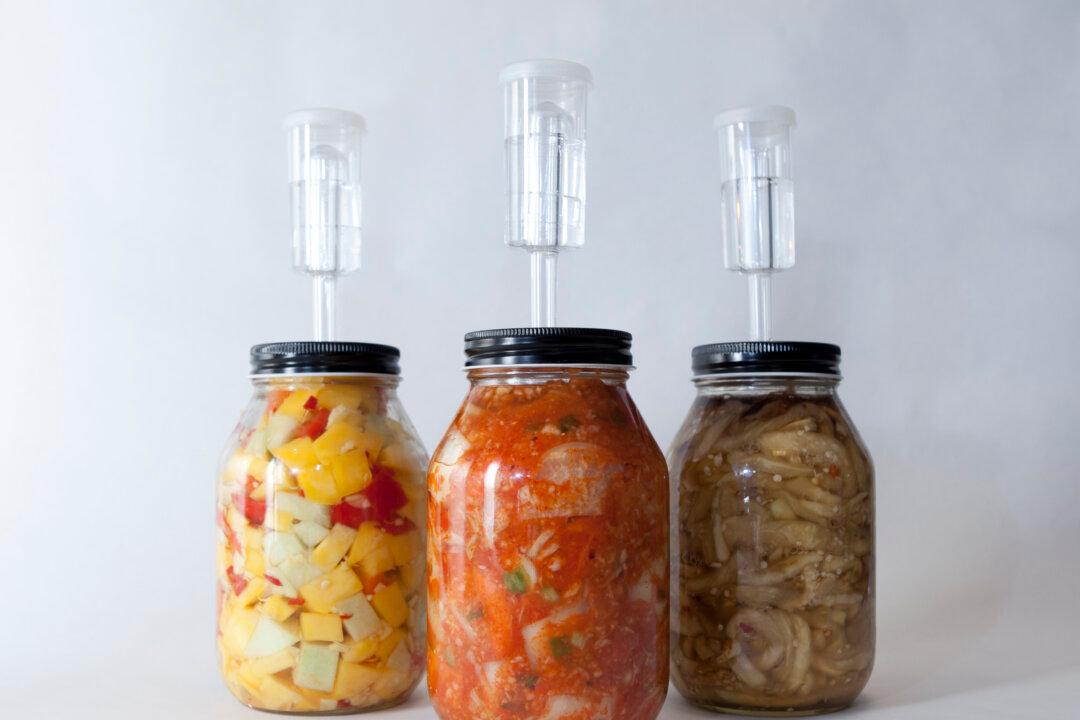The cold season holds a deep, mysterious magic for cooks. In the days of old, people resorted to methods even more ancient than fire itself to preserve food: fermentation.
A method 7,000 years old, fermentation relies on little else than vegetables (or fruit, for that matter) and salt. If you’re feeling extravagant, spices can be thrown into the mix.
Michael Schwartz, who runs BAO Food and Drink, and who makes delicious fermented greens besides kombucha, hot sauces, and other fermented goods, said there are hundreds of ways to ferment what we eat. “In America, we’ve lost that history,” especially since the industrial food production started taking hold in the 1950s, he said at a class this fall at the Institute for Culinary Education.
The health benefits are manifold. But they are not to be found in most commercially-made pickles, which boil and can their pickles. “If you’re looking for something that will add good bugs to your system that’s not it,” Schwartz said.
Good news is, you can make fermented goods at home easily. As a DIY gift, they’re wonderful for people who love the tangy, refreshing taste of pickled vegetables or fruits.
The first time, it takes a little faith, because you won’t taste the results of your pickling for days.
Organic vegetables are preferable (good microorganisms may well prefer a pesticide-free environment).
The steps as outlined by Schwartz are simple: wash your veggies well; cut them up about the same size; add seasoning (think garlic, ginger, apples, spices like coriander, bay leaf, chili peppers, “you can do whatever, even star anise,” he said); add salt (he recommends good salt, like Redmond’s, or Celtic, or Himalayan salt); mix and crush with your hands (the veggies will release juices); press into a glass jar or non-lead ceramic crock; keep the oxygen out (purchase an airlock for the whopping price of $1–$2 a piece).
Beyond that, said Schwartz, there are just two numbers to remember (and a scale comes mighty handy). If you’re making a brine, then use 1 ounce (make sure you measure by weight, not by volume) of salt per quart of water. If you’re not using a brine (and crushing with your hands or with a bowl to get the juices out), then use 0.4 ounce of salt per pound of vegetables.
Wait three or four days to taste. For his business, Schwartz prefers shorter fermentation times. “Americans are not used to fermented foods, they don’t like it funky,” he found, but it is completely possible and elsewhere the norm to ferment for weeks, if not months. Finally once you like the taste, move the jars into the fridge.
The following recipes are courtesy of Michael Schwartz of BAO Food and Drink. Each batch fills a 32-ounce jar.
Ol’ Style Pickles
1 pound cucumbers
Salt (1 ounce by weight per quart of water)
1 quart water
1 tablespoon dill or dill seed
4 garlic cloves
Sliced yellow onions (2 ounces by weight per pound of cucumbers)
10 black peppercorns
Bring water and salt to a boil, then cool.
Place aromatics in the bottom of the jar.
Layer cucumbers on top.
Pour cooled brine to top.
Screw lid with fermentation lock on tightly. (Add water in the lock.)
Leave in a warm place (approximately 75°F).
Check after four days.
Can ferment for up to four weeks depending on temperature and desired flavor.
American Kimchi
1 pound Napa cabbage
1 bunch scallions
1/4 pound daikon radish
1/4 pound carrot
1 ounce garlic
1 ounce ginger
1/2 ounce cayenne pepper
1 apple, cored
Salt (0.8 ounce per pound of vegetables)
Slice cabbage, green onion, carrot, and daikon. Mix with salt.
Puree ginger, garlic, and apple in blender.
Mix with cabbage mixture and press into crock or jar.
Screw lid with fermentation lock on tightly. (Add water in the lock.)
Leave in a warm place (approximately 75°F).
Check after four days.
Ferment for up to four weeks depending on temperature and desired flavor.
Traditional Sauerkraut
2 pounds green cabbage
Salt (0.4 ounce per pound of cabbage)
Spice options:
2 cloves smashed garlic or
1 tablespoon caraway seed or
1 tablespoon crushed black pepper
Cut the cabbage into chiffonade.
Mix with the salt and with gloves on squeeze and bruise, or press with heavy weight.
Place cabbage and any liquid into jar.
Add enough water to submerge if needed.
For each 1 cup of water, add an extra 1/8 teaspoon of salt.
Screw lid with fermentation lock on tightly.
Leave in a warm place (approximately 75°F).
Check after four days.
Can ferment for up to four weeks depending on temperature and desired flavor.
Sicilian Fermented Eggplant
2 large eggplants
8 cloves garlic
1 bunch oregano
1 teaspoon hot pepper flakes
Salt (0.4 ounce per pound of eggplants)
Peel and slice the eggplant fine julienne.
Mince the garlic and oregano.
Mix everything and place into fermentation jar.
Screw lid with fermentation lock on tightly. (Add water in the lock)
Leave in a warm place (+/- 75°F)
Check after seven days.
Can ferment for up to four weeks depending on temperature and desired flavor.
Fermented Mango Chutney
2 mangoes
1 apple
3 tablespoons ginger
1 tablespoon garlic
1 teaspoon chili pepper, minced
1 red bell pepper
Salt (0.4 ounce per pound of fruit)
Peel and dice the mango.
Peel and dice the apple.
Seed and dice the red pepper.
Mince the ginger and garlic and chili pepper.
Mix everything and place in fermentation jar.
Screw lid with fermentation lock on tightly. (Add water in the lock)
Leave in a warm place (approximately 75°F).
Check after four days.
Can ferment for up to four weeks depending on temperature and desired flavor.





